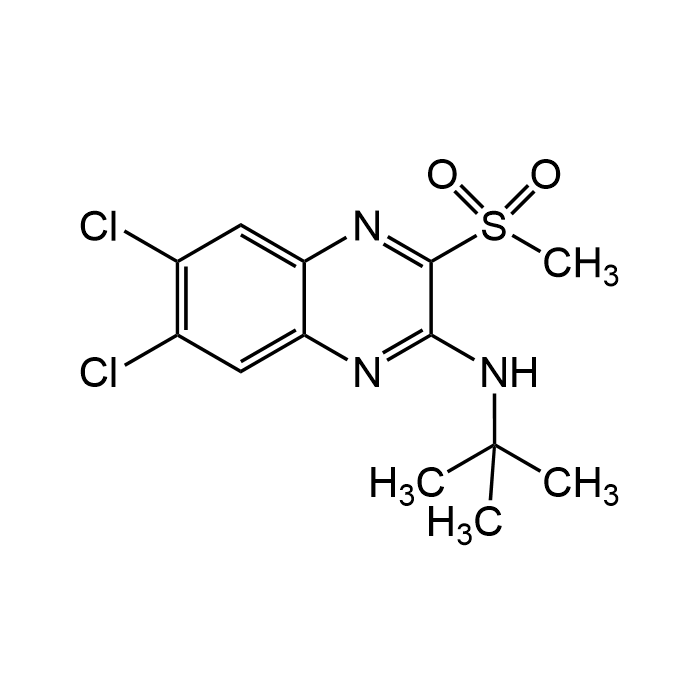Cookie Policy: This site uses cookies to improve your experience. You can find out more about our use of cookies in our Privacy Policy. By continuing to browse this site you agree to our use of cookies.
AdipoGen Life Sciences
DMB [GLP-1R Agonist]
As low as
50
CHF
CHF 50.00
In stock
Only %1 left
AG-CR1-3759-M0011 mgCHF 50.00
AG-CR1-3759-M0055 mgCHF 200.00
AG-CR1-3759-M02525 mgCHF 680.00

| Product Details | |
|---|---|
| Synonyms | GSDMD Activator; 6,7-Dichloro-N-(1,1-dimethylethyl)-3-(methyl-sulfonyl)-2-quinoxalinamine; 6,7-Dichloro-2-methylsulfonyl-3-N-tert-butylaminoquinoxaline (DMB) |
| Product Type | Chemical |
| Properties | |
| Formula |
C13H15Cl2N3O2S |
| MW | 348.2 |
| CAS | 281209-71-0 |
| Purity Chemicals | ≥98% (HPLC) |
| Appearance | Yellow solid. |
| Solubility | Soluble in DMSO (20mg/ml). |
| InChi Key | GNZCSGYHILBXLL-UHFFFAOYSA-N |
| Smiles | ClC1=C(Cl)C=C(N=C(NC(C)(C)C)C(S(C)(=O)=O)=N2)C2=C1 |
| Shipping and Handling | |
| Shipping | AMBIENT |
| Short Term Storage | +4°C |
| Long Term Storage | -20°C |
| Handling Advice | Keep cool and dry. |
| Use/Stability | Stable for at least 2 years after receipt when stored at -20°C. |
| Documents | |
| Product Specification Sheet | |
| Datasheet |
 Download PDF Download PDF |
Description
- DMB is a small molecule GLP-1 receptor agonist (GLP-1R; KB = 26.3 nM for the recombinant human receptor). DMB exerts its activating effect by forming hydrogen bonds with the Tyr42, Cys71 and Ser84 residues of GLP-1R.
- GLP-1 receptor signaling is a predominant mechanism for regulating glucose homeostasis. DMB represents a unique non-peptide tool for studying the role of GLP-1 in both in vivo and in vitro diabetes and obesity models.
- DMB is a selective small molecule gasdermin D (GSDMD) agonist for inducing pyroptosis and enhancing anti-tumor immunity.
- DMB can directly activate GSDMD-mediated cancer cell pyroptosis. Unlike traditional pathways requiring GSDMD cleavage, DMB induces pyroptosis without this step, effectively stimulating anti-tumor immune responses with minimal toxicity. It achieves this by covalently modifying the Cys191 residue in GSDMD, disrupting the interaction between the N-terminus (NT) and C-terminus (CT). This keeps GSDMD in an activated state without cleavage, promoting pore formation and inducing pyroptosis while preserving the overall GSDMD structure.
Product References
- Small-molecule agonists for the glucagon-like peptide 1 receptor: L.B. Knudsen, et al.; PNAS 104, 937 (2007)
- Insulin-releasing and metabolic effects of small molecule GLP-1 receptor agonist 6,7-dichloro-2-methylsulfonyl-3-N-tert-butylaminoquinoxaline: N. Irwin, et al.; Eur. J. Pharmacol. 628, 268 (2010)
- Allosteric ligands of the glucagon-like peptide 1 receptor (GLP-1R) differentially modulate endogenous and exogenous peptide responses in a pathway-selective manner: Implications for drug screening: C. Koole, et al.; Mol. Pharmacol. 78, 456 (2010)
- An Orally Active Allosteric GLP-1 Receptor Agonist Is Neuroprotective in Cellular and Rodent Models of Stroke: H. Zhang, et al.; PLoS One 11, e0148827 (2016)
- Intermittent Use of a Short-Course Glucagon-like Peptide-1 Receptor Agonist Therapy Limits Adverse Cardiac Remodeling via Parkin-dependent Mitochondrial Turnover: J.F. Germano, et al.; Sci. Rep. 10, 8284 (2020)
- A quinoxaline-based compound ameliorates bone loss in ovariectomized mice: Y. Zhou, et al.; Exp. Biol. Med. 246, 2502 (2021)
- Small-molecule GSDMD agonism in tumors stimulates antitumor immunity without toxicity: P. Fontana, et al.; Cell 187, 6165 (2024)
- DMB-induced GSDMD-mediated pyroptosis: a novel therapeutic strategy for enhancing anti-tumor immunity: J. Shentu, et al.; Cell Death Discov. 10, 482 (2024) (Review)





